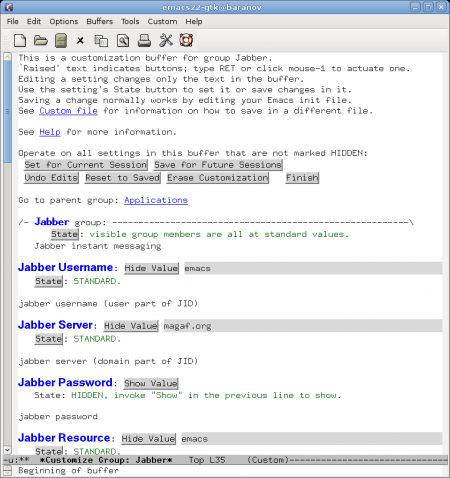jabber.el or emax jabber client
 Recently, I began to spend a lot of time in the
Recently, I began to spend a lot of time in the So, I want to start with the fact that jabber.el is developed separately from emacs, so it is not included in the standard package, but it can be easily installed, for example, in Ubuntu, installation is reduced to one line in the console:
sudo aptitude install emacs-jabber
Personally, I It seems that the repositories of various Linux distributions contain a fairly old version of jabber.el, so I prefer to get the jabber client from the git repository of Kirill Korinsky - one of the developers of jabber.el.
So, after installing jabber.el, you need to include it in the Emacs configuration file called (.emacs). Add the following line there:
(require 'jabber)
After that we start emacs. So, we indicated to emacs that we need to load the jabber.el module at startup, now we need to configure the jabber account. In emacs we type:
Mx jabber-customize,
after that we get to the settings page for connecting to the jabber server.

After configuration, we can connect to the server using the
M-x jabber-connect command .
Or, using the C-x Cj Cc keys. Don’t be afraid, these huge keyboard shortcuts can naturally be made automatic, for example, connect to the jabber server when the editor starts, or Assign this large combination of keys to some kind of shortcut that is convenient for you, for example, assign the connection to a key. To do this, add the following line to the Emacs config:
(global-set-key [f5] 'jabber-connect)
After connecting, you can switch to the roster (contact list) using the
M-x command jabber-switch-to-roster-buffer
Or the keyboard shortcut Cx Cj Cr
At the top of the roster is a short list teams. For example, to enter the conference, you must press j , and to start a dialogue with one of the contacts, you need to move the cursor to it and press Enter .
Another interesting action: let's say that we want to switch to a buffer where we have unread messages, just do this:
Mx jabber-activity-switch-to
Or, better, add this thing to the Cx Ca hotkey config :
(global-set-key "\ Cx \ Ca" 'jabber-activity-switch-to)
And it would also be interesting to include spell checking in message buffers, for this we add the following line to the config:
(add-hook' jabber-chat- mode-hook 'flyspell-mode)
I found this here.
As you can see, an interesting emax mechanism is used here - hooks, i.e. launching some specified functions upon the occurrence of an event (in our example, when switching to chat mode, and this mode is used in all jabber.el message windows, spelling is checked on the fly).
In my short article, of course, I did not describe the hundredth share of the capabilities of jabber.el, and even more so Emacs, because I am as new to Emacs as many others. I would like to note that many questions that people from the conference emacs@conference.jabber.ru helped me solve and I am very grateful to them for this.
And in conclusion, I want to say that perhaps such a jabber-client will seem uncomfortable for a beginner, but believe me, after a few weeks of close communication with Emacs, you will look at it in a new way.
